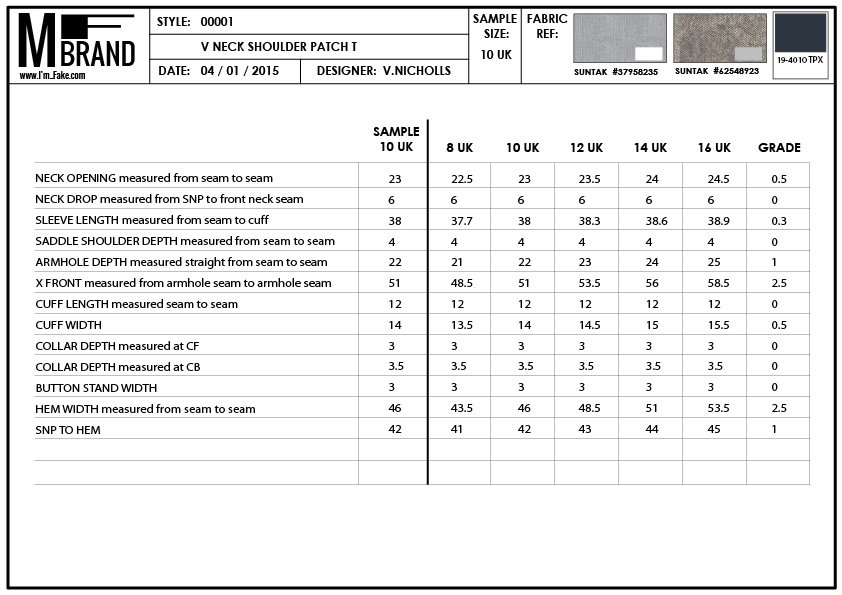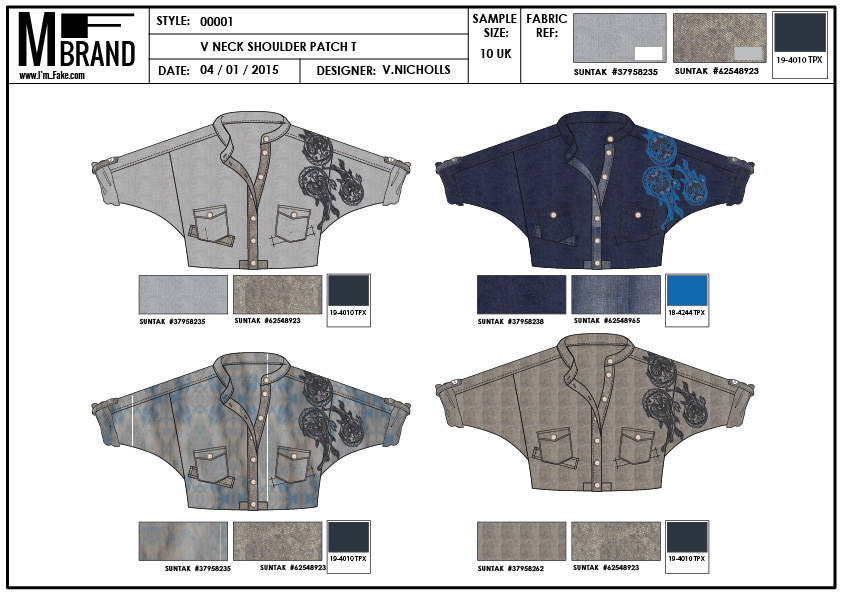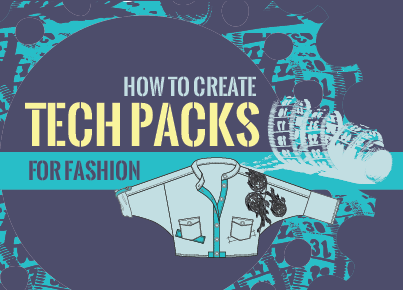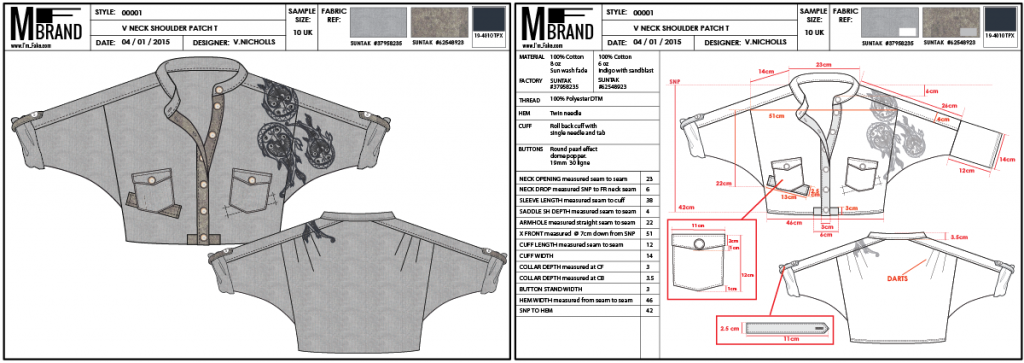If you have ever needed to get a Tech Pack made for clothing, you’ll know that it’s quite a complex document. If you’ve never had a Tech Pack done for your product or collection, then you are about to discover how the professionals put one together.
In this post I’m going to cover the contents of a basic fashion Tech Pack. We’ll look at the individual pages and why they are needed.
By the time you’ve finished the post, you’ll know what to look for when you are deciding what is a good Tech Pack and what is a bad one, and if you are asking a professional to do them for you, you’ll understand who to hire and what should be in there.
BUT FIRST…..WHAT IS A TECH PACK?
When you’ve decided on your amazing designs for your product or collection, you then need to get your products made. To do that, you’ll need a factory or dressmaker, depending on the scale of your production. More importantly, [and this is the bit that can halt you in your tracks] is how you are going to explain your idea to someone else?
A Tech Pack is a blueprint that tells a factory, in a special language of drawing and terminology, how your finished garment should look and how it should be made.
A tech pack can cost, depending on how complex they are, anything from US$ 50 to $400. Unfortunately, these skills aren’t really taught in universities and are discovered by designers through experience. The quality varies greatly, depending on who taught them and how knowledgeable they were.
The aim of a good Tech Pack is to layout the blueprint for your product, but what most people don’t realise is, that depending on the quality, they can also save you time and money.
THE GOOD THE BAD AND THE UGLY….
If a Tech Pack is done well, the first sample you get back from a factory should be near enough what you want. It may need a tweak or two, or the factory may not have made every part to the measurements asked for….but essentially, it should be correct. Since you will pay for every sample that the factory has to make, [unless they haven’t followed the spec properly] the quality of a Tech Pack is pretty important to your budget and your time scale
If you get a bad quality pack, you could end up paying for 8, 9, 10 samples before it starts to look right. Plus shipping for each sample. And fabric…..and trims….. and buttons….. or zips….. and personnel cost….. so you see now, when you add up all of the costs involved, the cost of a Tech Pack isn’t looking so bad even at the higher end. Trust me! It will cost you far more to do 5 rounds of sampling than to pay for a good pack!
When I look on the internet, I can see that a number of the example Tech Packs, although they look good, would actually make your life harder, than actually help you. Without experience you might be worried about who to hire or taken in by the nice layout and pretty drawings. But fear not. I’ll cover the basics. But before we get into that, let’s talk about why I’m NOT suggesting you attempt this on your own in the beginning.
HIRING A PRO…..
These documents are very specific. They take a lot of knowledge of body measurements and grading [to a retail standard-not dressmaking]. Technical pattern making and construction. Knowledge about industrial machinery and how each type of fabric adapts as its shape changes….. at least in a good one. And I’ve already shown you how bad ones can affect time and money.
If you’re new to this part of the process, I wouldn’t advise doing this yourself. There are far too many moving parts and if one changes, that can set off a chain reaction in other areas.
This part of your journey is very, very important, so I would truly advise spending some of your budget here, where it will count the most.
Due to their specialist language, which is done in drawing and terminology, designers will charge anything up to US$400 per pack. Personally, from what I’ve seen, I wouldn’t pay that much for one. However, please be aware that depending on how complex each design is, they can take up to 8 hours…..just for 1 pack [1 design]. So in the same way, if you find services that are less than $70, I would seriously be worried about quality.
Most freelancers rely on people not really understanding them or what they should contain and find it easy to overcharge for poor quality. At FSHK, my Fashion Services company, I carry the weight of paying my designers, rather than passing the charge onto my clients. So ours are only $120 upwards. It’s a little on the cheap side for the work involved, yes, but I want to make sure that each person gets the chance to get their brand off to a good start. Plus the more people who can learn what is in a good Tech Pack, the more you tell other people, the more knowledge is out in the world and the more people I can help. I’m more than happy with that.
If you think however that you have some experience and think you are ready to try doing your own, you might also be interested to know that I’ll be releasing a book specifically on Tech Packs, which will show you how to create one. This will be out later in 2015. If you’re interested, you can click HERE to find out more. [The link will take you to our sister site, Fashion Services]
But let’s get back to the Pack itself.
THE INSIDE OF THE PACK
There are 3 main skill parts of a Tech Pack. The pages that show the garment drawing and all of its measurement’s. Grading for all sizes if you want it. [This is optional but requires some maths] and the Language used to draw and explain the construction.
The 3 parts are used all over the entire Tech Pack and its works like this….
COVER PAGE
[Pictured top left]
This page shows the garment in all its colourful glory. It should be the only place where the drawing is in colour and has the basic info about the style. Style number. Date. Size. Colour References. Date it was produced on. You should also brand your Tech Pack with a logo or name, to make it clear that it’s yours. By the time you come to create your Tech Pack, or get someone else to create it for you, you’ll have a clear Brand Identity and logo that you’ll be able to add in.
SPEC PAGE
[Pictured top right]
This is the real blueprint page. The aim, is to give clear instructions to the factory making the sample, how to construct each garment. The drawing is in black and white and shows the factory where to measure to and from and what those measurements should be. It gives details about trims, construction and fabrics, as well as the basics above.
This is the main area where “language” is used. The way the sketch is drawn is very specific. This is a language
in itself. The different line weights of the drawing mean different things to the factory. Also, the terms used to describe certain parts of the garment. The machinery and techniques used in factory production are very specific. Even depending on the type of garment……
Did you know that the bit that has buttons and holes for buttons, like the front of a shirt, is called a button stand….. well it’s not on knitwear. It’s a placket! See what I mean….
Your factory speaks this language and understands the drawn language, not the language of dressmaking which is the “hobby” version.
GRADING PAGE
[Pictured right]
This gives the same points of measurement as the main Spec page, but changes the measurements per size and tells the pattern cutter how to grade each pattern piece when creating them.
This is pure maths and takes a good bit of experience to understand the grades for ages, body shapes and material.
You don’t need this page to just get a single sample, but you might want to include it if you are paying someone to do the pack for you. It will save you time and money later if you are planning to do the design in a few sizes during “bulk productions” or large orders.


SAMPLING PAGE.
This is a record of your samples and should be kept as a record of the comments and measurements of the samples you get back.
You’ll find that a factory will photocopy this page and a member of staff will QC [Quality Check] the sample before they send it.
Please, please, PLEASE check this again yourself. It’s amazing how many times the factory QC measures something the same as the Spec Sheet measurement and when I do it…….SURPRISE!!!! It’s not the same.
OPTIONAL PAGES
There are a number of other pages that are optional, depending on how ready you are for sampling and what type of product you are trying to create. Essentially each page will have the same general layout as all of the others and key pieces of information like date and style number and so on. These pages can include:
- Colour options [or colourways] to show what colours the product comes in.- pictured below
- Labelling sheets for garment labels
- Prints or embroidery artworks that go on top of the fabric
- Garment views like side or turned 3/4, depending on the features of the product.
- Detailed construction notes

A FEW FINAL TIPS
So OK I’ve given you the basics but now, since most people will hire a designer in the beginning, I want to give you some really good tips for things that you need to watch out, and where a warning signal should go off in your head. Remember QUALITY reduces your costs.
BAD TECH PACKS
- Never hire anyone that shows you a picture that has a drop shadow behind it or any kind of pretty illustrations. A Tech Pack is not supposed to look nice and presentable. You have to remember it’s a technical document.
- Never hire a designer that shows you pictures where there is a thick black line round the outside of the whole garment shape. This has become popular because of a trend site called WGSN but the drawing language is actually wrong.
- Never hire a designer that makes the garment look 3D. It should always be drawn flat [hence the name Flat drawing] – again this is just designers copying WGSN
- Never hire a designer that can’t get all of the technical details onto 1 [at a push 2 for something complicated] Spec Sheet page. The more pages a Tech Pack has, the more they tend to get lost in a factory!!!!!!
- Never hire a designer that only explains the details of the garment in written form. It basically means they haven’t drawn the flat drawing properly or they don’t know what the correct language is. Their drawing should be done well enough that it shouldn’t need explanation. If it’s something complicated and they are playing it safe, then really it should be more drawing and little text. But essentially if there is a lot of text around the Flat Drawing….. Warning Bells…. Stay away.
- Never hire a designer that says they can do this, and this, and this, and this and this and…… They don’t exist! All designers have areas they are good are sure, but not everything. Pick specialists that can do 1 or 2 things really well. For example. Many childrenswear designers are also really good at graphics and prints because of the type of work they do. Knitwear designers should be able to do jersey because the construction and stretch fabrics work the same way. But neither would also do underwear or shoes or each other’s job……
And remember…. Your Tech Pack may be specialised. You may need additional pages [ see below ] that are essential, so will have to trust your gut and use your common sense.
Secondly, most designers are never taught Tech Packs at university, in books or courses. It’s definitely on the job training. So if you find a designer that isn’t great, then please help them.
So what SHOULD you be looking for?
- Well basically my tech pack above. Use it as your template
- The drawing needs to look like it’s flat. Laid on a table. Not on a person.
- No effects to glam up the Flat drawing, like drop shadows and thick lines. Sorry but the Spec page should a bit boring and plain. Go nuts on the cover sheet if you want though!
- Look for a Spec sheet that is clear. Minimal text. A few words here and there at most. As much on 1 page as possible. 2 MAX! The sheet should be Clear, Efficient and Graphical.
- The measurements…. Ask to see a grading page. If they’re not including one, then they don’t actually know how to and have probably never done one before.
- Check off the points on the previous Bad Tech Pack section. Make sure they don’t have any of those details in their Tech Pack examples.
- Look for someone with Supplier experience on their CV. Working with factories or even Tech Packs. [ Then ask to see a few different examples ] Big name universities and Brands are all very well and good, but if their experience is in Luxury brands, trust me they’ve never had to do a Tech Pack ever!
FINALLY….
So far, we’ve covered what a Tech Pack is and how a good and bad one can affect your time and budget. Hiring a Pro. What is inside a Pack in terms of the pages and content and lastly, tips on what a good and a bad Tech Pack is, which will help when hiring a designer.
[wc_fa icon=”cogs” margin_left=”” margin_right=””] Action Steps:
Now I want you to take action with a little task. Open a second internet browser page and type in “Tech Pack”. Look at the images that come back and in the comments below tell me what you think about the amount of good Tech Packs there are on the internet…..
P.S.
If you want to try a Tech Pack for yourself, but are unsure of where to start, you can find out more in my E-Book, which will take you on a step by step journey from start to finish. How To Create Tech Packs For Fashion, is a 260+ page E-Book that covers: measurements, sampling, technical fabrics and language, how to create a Flat Drawing and how to put a Tech Pack together.
You can find more details and look inside the Book, by clicking this link:



